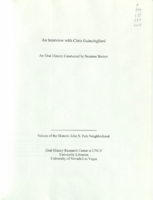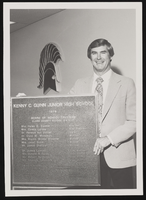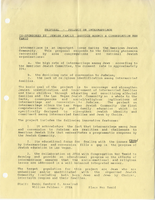Search the Special Collections and Archives Portal
Search Results
Megan Griffard oral history interview, 2024 August 22
Level of Description
Scope and Contents
Oral history interview with Megan Griffard conducted by Claytee D. White and Stefani Evans on August 22, 2024 for the UNLV Remembers: an Oral History of the 6 December 2023 Shootings project. In this interview, Griffard, UNLV assistant professor in the educational policy and leadership program, describes taking her 18-month-old daughter to the UNLV/CSUN Preschool on the UNLV campus before going to her office. She initially planned to go to the Student Union, where her colleagues had prepared poster presentations when she received the first alert and hid under her desk. Her husband called to tell her he had been called to prepare for mass casualties at UMC and the freeway was closed. She texted her dad, her coworkers, and called the preschool while hiding under her desk. She describes trying to get to the Methodist Church across Maryland Parkway, the designated spot for the preschool parents to be transported to the preschool to pick up their children. When her turn finally came, she was driven to the school and passed through layers of security before she could retrieve her daughter. Her husband soon arrived and the family was eventually able to go home together. The next day, Griffard returned to campus with her colleague who had been in the Student Union. The following Monday, Griffard and her coworkers held a Zoom meeting to check in with each other and talk about their experiences. She talks about the importance of finding the right therapist, learning how to process painful events, and realizing how her recovery has helped her shut down a tendency to people-please. Digital audio and transcript available.
Archival Collection
Collection Name: UNLV Remembers: an Oral History of the 6 December 2023 Shooting interviews
Box/Folder: Digital File 00 (Restrictions apply)
Archival Component

Transcript of interview with Chris Guinchigliani by Suzanne Becker, July 20, 2007
Date
Archival Collection
Description
Text

Transcript of interview with Donald C. Brinkerhoff by Stefani Evans, September 30, 2016
Date
Archival Collection
Description
Las Vegas tourists who stop to admire the Mirage volcano, the Bellagio conservatory, the Wynn Las Vegas mountain, the Encore gardens, and the iconic Welcome to Las Vegas sign’s surroundings on the Las Vegas Strip likely do not realize that in each case they have sampled a unique landscape environment conceived by Don Brinkerhoff of Lifescapes International, Newport Beach, California. It is for producing work of this caliber that in 2016 the American Gaming Association selected Brinkerhoff to be the first designer inducted into the Gaming Hall of Fame. In this interview, the Los Angeles native and son of a working-class father and an artist/schoolteacher mother, explains how he spent his youth in an owner-built house in the modest suburb of El Monte, where he tended the family truck garden. Despite earning his degree in ornamental horticulture at California Polytechnic (Cal Poly), Don felt unschooled in the arts because the small school did not teach them. To fill that educational gap, Don took his wife and four children to Europe for two years, where he affiliated with the American Academy in Rome and worked for TAC (The Architects' Collaborative) in Greece among other adventures. The family spent another six months in Hawaii, where the children attended school and Don worked with a local landscape architect. The family’s unusual work, school, and travel experience more than completed Don’s arts education and shaped his world view and that of his daughter Julie in countless ways that came to silently benefit the Las Vegas built environment. Upon returning to California in 1968, Brinkerhoff opened his Orange County office, and Lifescapes International became the “go-to” firm to create water features for condominium projects. This work led to his first hotel-casino project at a Sun City golf course condominium project in South Africa, which in turn led to a telephone call from architect Joel Bergman inviting him to become one of three candidate landscape architects to work with Steve Wynn on what would become The Mirage hotel-casino in Las Vegas. Here, Brinkerhoff speaks to his design philosophy as ninety percent problem-solving and ten percent inspiration even as he describes organizing the signature tree for The Mirage, building the Mirage volcano, taking the idea for Bellagio’s conservatory from the DuPont family’s Longwood Gardens, of creating faux banyans in the Mirage atrium, of creating the model for the Las Vegas Strip median, and of building the mountain on Las Vegas Boulevard in front of Wynn Las Vegas to conceal the Cloud at the Fashion Show Mall. While the fortunes of Lifescapes International continue to grow and succeed worldwide, both Don and Julie credit Steve Wynn and their Las Vegas work: “Las Vegas has totally changed our lives.”
Text

Transcript of interview with Colleen Gregory by Tim Waters, April 6 & 7, 1976
Date
Archival Collection
Description
On April 6 and 7, 1976, Tim Waters interviewed Colleen Gregory (born 1928 in Santa Clara, Utah) about her life in Southern Nevada. Gregory first talks about her original move to Las Vegas, her early education, school activities, and her college education. She also talks about the first banks, Helldorado, the atomic testing, and environmental changes. Other topics covered include Howard Hughes, Western-style influences, first properties on the Strip, World War II, racial prejudice, and changes she has noticed during her career in banking.
Text

Portrait of Dr. Kenny C. Guinn: photographic print
Date
Archival Collection
Description
Image
University of Nevada, Las Vegas Division of Student Affairs Records
Identifier
Abstract
University of Nevada, Las Vegas Division of Student Affairs Records contains reports on student demographics and usage statistics of the Student Services program, as well as inter-departmental correspondence that date between 1958 and 1979. The collection also contains correspondence with external departments, committees, and professors. The majority of the correspondence is dated between 1970 and 1977 and is primarily from Dr. Robert E. Glennen, UNLV's Vice President for Educational Services at the time. The collection also contains student handbooks, codes of conduct, Greek Life information, Moyer Student Union newsletters and brochures, and other student-related material.
Archival Collection

Barry Holt interview, February 11, 1977: transcript
Date
Archival Collection
Description
On February 11, 1977, collector Lee LaVecchia interviewed Barry V. Holt (born January 20th, 1946 in Las Vegas, Nevada) at his home in Las Vegas, Nevada. In the interview, Mr. Holt speaks about the differences between growing up in Las Vegas in the fifties and sixties compared to how his children are growing up at the time of the interview. He also discusses education and the religious community in the city.
Text

Transcript of interview with Alice Cowles Brown by Eric M. Cheese, March 31, 1981
Date
Archival Collection
Description
Text


